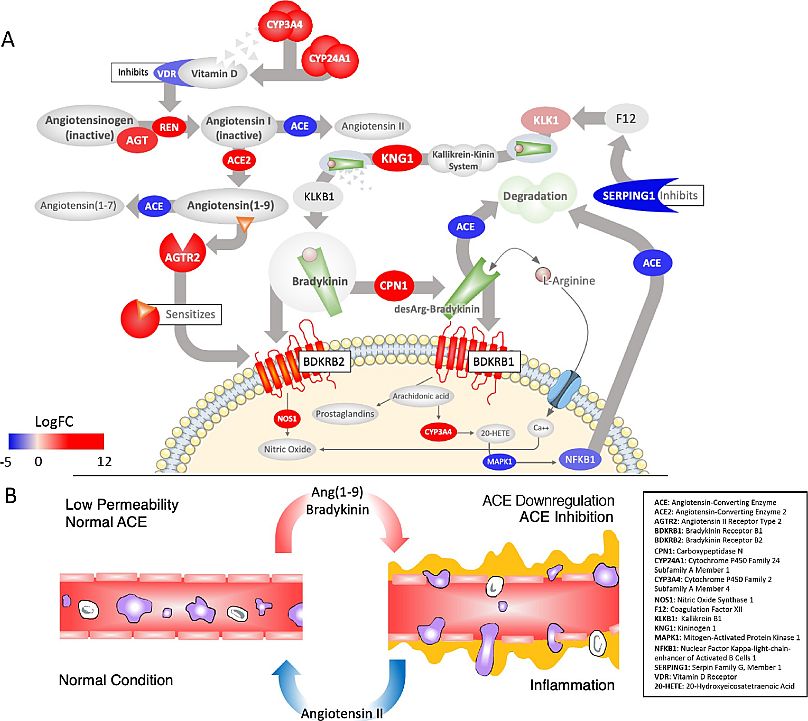Despite Summit being the second-fastest computer in the world, the process took over two weeks.
A genetic study of COVID-19 patients, powered by the Summit supercomputer, may have taken us a step towards understanding how the new coronavirus causes disease.
Summit, located at the Oak Ridge National Lab in the US, analysed 40,000 genes from 17,000 samples earlier this summer in an attempt to understand the virus, AI expert Thomas Smith explained in an article on the Medium platform.
While the machine is the second-fastest computer in the world, the process required it to analyse 2.5 billion genetic combinations — a feat that took over two weeks.
Its results pointed to the fact that bradykinin, a natural chemical compound that regulates blood pressure, could explain many facets of COVID-19 and some of its symptoms.
The findings may shed light on why the virus causes vascular problems in certain patients, from strokes to inflammation of the skin or toes, as well as indicating new potential therapies to treat its worst symptoms.
Understanding COVID-19 — a race against time
Faced with a new virus and unknown disease, health authorities and medical staff have been learning as they go how to treat the new coronavirus.
At first, the virus appeared to manifest as a respiratory syndrome — its full scientific name is still Severe Acute Respiratory Syndrome 2, SARS-CoV-2 — with symptoms similar to a bad cold or the flu and treatments reflected this.
But soon, front-line doctors began to report other symptoms that were more severe: strokes, heart problems, skin conditions and circulatory problems, mainly in the feet. Hormonal problems were also detected in some cases.
Healthcare workers started to realise that giving critically ill patients oxygen or intubating them, which is the initial protocol for respiratory failure, did not always get the desired results. Something else was at work.
Little by little, signs pointed to the most serious cases and deaths being due to a cytokine storm — an exaggerated response of the patient's immune system, capable of damaging vital organs.
The scientists who interpreted Summit's data, who published their findings in eLife journal, believe that a bradykinin storm — a dysfunction of the vascular system that causes blood vessels to leak —could be to blame.
Although, they added that it is possible the two storms are "intricately linked".
'Bradykinin Hypothesis': COVID-19 like a burglar who throws open your windows
The Bradykinin Hypothesis suggests that a bradykinin storm is responsible for many of COVID-19’s deadliest symptoms.
The theory is based on the commonly accepted notion that the infection begins with the virus entering the body through ACE2 receptors — widely present in the nose, but also in the intestines, kidneys, and heart.
Summit showed the team of researchers that the effects of COVID-19 were not limited to those caused by the colonisation of ACE2 receptors: the virus is capable of manipulating them too.
Instead, it actively hijacks the body’s own systems, tricking it into increasing the response of the receptors.
COVID-19 doesn't just infect cells that already express a lot of ACE2 receptors, instead it actively hijacks the body’s own systems so it is tricked into upregulating them in places where they’re usually expressed at low or medium levels, including the lungs, Smith said.
"In this sense, COVID-19 is like a burglar who slips in your unlocked second-floor window and starts to ransack your house. Once inside, though, they don’t just take your stuff — they also throw open all your doors and windows so their accomplices can rush in and help pillage more efficiently," he added.
SARS-CoV-2 increases levels of ACE2, which lowers blood pressure in the human body and works against another enzyme known as ACE (this has the opposite effect), leaving the door open for bradykinin, the researchers wrote in the scientific journal.
Uncontrolled bradykinin causes vascular permeability and dilation as well as hypotension, they added.
When respirators are useless
Once blood pressure is not controlled and blood vessels increase their permeability, the body has opened its doors to dysfunctions in almost the entire body — and the doors stay open.
COVID-19 patients affected by a bradykinin storm "drown" because their lung alveolus are coated with a jelly-like substance.
Many health workers had reported damage to the blood vessels of the respiratory system and other organs.
This would explain why in some cases administering oxygen or connecting patients to respirators was futile.
Could this hypothesis be used to identify at-risk patients?
Another of COVID-19's mysteries is the reason why some patients have suffered more than others from more serious symptoms, although there are known risk factors including as age, being overweight and diabetes.
Speculation has pointed to genetic factors, microbiota or even blood group as an explanation for this.
The Bradykinin Hypothesis could help us understand who is most at risk of being badly affected by the virus.
Increasingly, it seems that women are less likely to die from COVID-19. Researchers believe that the presence of a protein (thymosin beta-4), which is twice as high in women as in men, could protect women from some of the novel coronavirus' worst symptoms.
How might this help find a treatment?
The researchers suggested that efforts to find a treatment for symptoms should be focussed on curbing bradykinin storms.
"Further experiments identified several existing medicinal drugs that have the potential to be re-purposed to treat the Bradykinin Storm," they wrote.
"A possible next step would be to carry out clinical trials to assess how effective these drugs are in treating patients with COVID-19.
"In addition, understanding how SARS-Cov-2 affects the body will help researchers and clinicians identify individuals who are most at risk of developing life-threatening symptoms."













